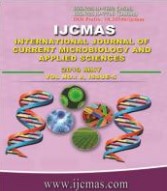


 National Academy of Agricultural Sciences (NAAS)
National Academy of Agricultural Sciences (NAAS)

|
PRINT ISSN : 2319-7692
Online ISSN : 2319-7706 Issues : 12 per year Publisher : Excellent Publishers Email : editorijcmas@gmail.com / submit@ijcmas.com Editor-in-chief: Dr.M.Prakash Index Copernicus ICV 2018: 95.39 NAAS RATING 2020: 5.38 |
A field experiment was conducted at the Experimental Farm, Department of Horticulture, Assam Agricultural University, Jorhat during November 2016 to march 2017 to study the “Performance of Chilli (Capsicum annuum) cv. ‘Krishna Jolokia’ as influenced by organic inputs and microbial consortium”. The results indicated that application of RDF (T1) recorded the highest plant height (82.38 cm), fruits plant-1 (98.56), fruit length (7.99 cm), fruit girth (1.01 cm), fruit weight (2.09 g), fruit yield plant-1 (268.33 g), fruit yield per hectare (13.07 t) with the B:C ratio of 4.60. Among organic treatments the highest plant height (79.85 cm) found in T3 and the highest number of fruits plant-1 (95.63), fruit length (7.98 cm), fruit girth (0.98 cm), fruit weight (1.91 g), fruit yield plant-1 (256.63 g) and fruit yield hectare-1 (12.07 t) were found in treatment T5. However, among the quality parameters, the highest ascorbic acid content (80.90 mg 100g-1) in T5, moisture content (91.14%) in T1 and pungency (35,000 SHU) in T7 were recorded. The present investigation revealed that most of the growth, yield and yield attributes were found highest in treatment receiving RDF. Considering the adverse effect on soil health and environment it is not advisable to use chemical fertilizers at a higher quantity. A study led to the conclusion that good growth, yield with better quality of chilli can be achieved by judicious application of organic, inorganic and biofertilizers.
 |
 |
 |
 |
 |